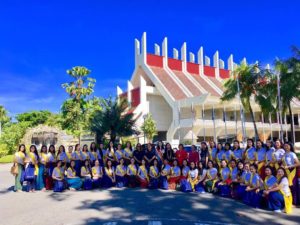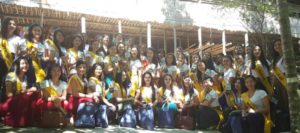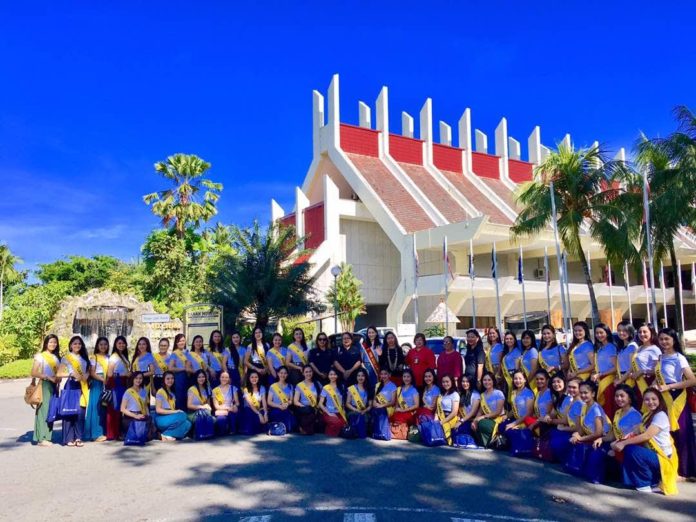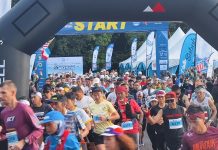
A tour of the Sabah State Museum is one of the activities carried out by participants of the State Level Harvest Festival Beauty pageant. The 44 young ladies representing the districts in the State visit the various areas of the museum for an educational tour. They learn more about their cultural and traditional heritage here by looking at the artifacts and listening to talks by knowledgeable individuals. Such visits ensure that these beauty queens who represent their respective districts and ethnic background have some knowledge of their own traditional background.
It cannot be denied that most young people nowadays are no longer in touch with their traditional and cultural heritage. As the Museum is packed with traditional, cultural and historical artifacts, it is the best place to visit if one wants to know more about the indigenous people of Sabah.
Actually, tour guides who have shown our rivers, forests, flowers, water falls, sea, sun, sand and edibles to guests can add the Museum to their itinerary.
A visit to the Sabah Museum is recommended for guests if they want to know more about the people’s cultural heritage and the State’s history, social and natural history. In the Museum, you can see them all in one place.
First of all there is the Time Tunnel, a gallery that shows prehistory; through archaeological and antiquity studies. On exhibit is Stone Age artifacts found in Tingkayu archaeological site and Madai caves. They are believed to be 20,000 to 25,000 years old. These are considered to be examples of the finest stone tools discovered in South East Asia. Human presence have also been detected at the. Baturong, Madai, Gomantong and Tapadong caves.

A replica of the only known prehistoric rock carving in Sabah is also displayed here. This is the Tomani (in Tenom) rock carving.
Folklore has it that it was made by five brothers who expressed their grief in the carving at the death of their youngest brother.
A replica of a cave is also exhibited here. This cave actually seeks to show guests how the caves in Sabah look like. One fine example of functional caves (at least in the past) is the Agop Tulug Caves in Kinabatangan; The Agop Tulug is used to as burial ground in the olden days. Within the caves are carved coffins more than 250 years old.
In fact, the simulated cave at the houses a pair of intricately carved coffins which are two of the old coffins found in the Agop Tulug caves.
Some section of the Time Tunnel shows the evolvement of the State in modern age. There you will be able to see how the State grew from the colonial era to how it is today. This includes the British administration during the colonial days, the Second World War, and the independence of Sabah. Visitors will be able to read the political statements of the leaders of yesteryears.
The people belief in those days borders on the mystical; where they are spirits in every living beings even inanimate subjects like stones, rocks and boulders. They carry out rituals to appease these spirits. In these rituals earthen containers are used.
The rites and rituals are almost gone now, but you can view the vessels that were used in the ceremonies.
A gallery is dedicated to these items; there the various wares that were used are exhibited. The vessels were acquired by barter trade. Also on display are several ritual jars which are used by the local people for burial and as dowry.
The rich and diverse zoological and botanical heritage of Sabah is also on exhibit at the Natural History Gallery. Preserved local zoological specimens are also displayed.
A gallery is also dedicated to the people of Sabah. Called the Colour, Cloth and Costumes gallery, traditional attires of the indigenous people of Sabah are on display there.
The traditional costumes, headgear and personal ornaments of the seven main groups of people are shown here. As we all know each group have their own costumes and attires so the exhibition is quite colourful to say the least.
The seven groups represented in the gallery are: Bajau, Kadazan Penampang, Lotud, Rungus, Suluk, Murut and Dusun Tindal.
For a look at the people’s traditional home, the Sabah Museum Heritage Village sited within the Ethno-botanical Gardens, in the Sabah Museum Complex, is a good place to go. The Village displays replicas of traditional houses which are made up of 11 units of houses of the local communities from various areas in Sabah. The houses are surrounded by lush plants which The ethno-botanical garden found here consists of herbs and ritual plants used by the people since time immemorial.
The traditional houses there depict the usage of wood and related materials by the people. They show how ingenious the people were in the utilisation of wood and other plant material. I am informed that the houses were built by the relevant ethnic group to ensure authenticity.
To emphasise this authenticity, the houses are furnished with items that are part of the people’s household in the past. They include bamboo water containers, spoons, ladles and various others.
Occasionally activities such as handicraft making demonstrations and sales, cultural dance performances and traditional games are held here. These activities are usually carried out during the month of May, to coincide with the State level Harvest Festival Celebrations.
There are many interesting artifacts and sights that can be viewed at the Museum and of course for photography buffs the museum ground can be a treasure of scenes and angles.
The Sabah State Museum is indeed where one can know more about the indigenous people of Sabah without having to visit far flung villages.-CE/BNN






